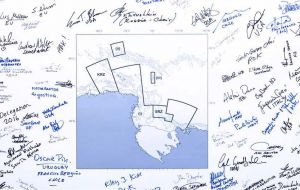MercoPress. South Atlantic News Agency
Ross Sea region MPA serves as a valuable model for others in region
 Iconic emperor penguins are one species that benefits from marine protections established in Antarctica’s Ross Sea in October 2016
Iconic emperor penguins are one species that benefits from marine protections established in Antarctica’s Ross Sea in October 2016  A map of the Ross Sea region MPA was signed by CCAMLR delegates after the successful designation in October 2016. (Pic John B. Weller)
A map of the Ross Sea region MPA was signed by CCAMLR delegates after the successful designation in October 2016. (Pic John B. Weller) By Andrea Kavanagh (*) - On October 28, 2016, global leaders made history by designating one of the most productive and healthy stretches of the ocean as the world’s largest marine protected area (MPA).
Establishing the Ross Sea region MPA required the efforts of hundreds of scientists and officials, thousands of conservationists, and millions of global citizens over the course of more than a decade. In the end, it involved reaching consensus among the more than two dozen governments that comprise the Commission for the Conservation of Antarctic Marine Living Resources (CCAMLR), the decision-making body that manages the Southern Ocean. CCAMLR is among the few multinational bodies that has developed high seas MPAs, and it is committed to creating a representative network of Southern Ocean MPAs.
As the first large-scale MPA in areas beyond national jurisdiction, the Ross Sea region MPA sets a precedent for design, adoption, and implementation of other MPAs on the high seas. Together with a team of co-authors, we recently had a paper published in Marine Policy that highlights the strong management in place within the Ross Sea region MPA, including research and monitoring. We also described how and why the majority of this MPA qualifies under the new MPA Guide as being highly protected.
The Ross Sea region MPA covers 2.09 million square kilometers, with almost 80% (1.66 million square kilometers) closed to commercial fishing. It is designed to achieve a suite of specific objectives:
• To conserve biodiversity, ecological structure, and ecosystem dynamics and function throughout the Ross Sea region.
• To protect ecosystem processes, core distributions of species, vulnerable habitats, and areas of importance to the life cycles of toothfish, seals, and penguins.
• To promote research (including monitoring).
• To provide reference areas for studying and separating the impacts of environmental change and fishing.
CCAMLR as a whole (which includes 25 countries plus the European Union) is responsible for managing the Ross Sea region MPA, but many technical aspects of the work (e.g., compiling data, supporting monitoring and compliance) are the responsibility of the CCAMLR Secretariat, which is based in Hobart, Australia.
Research and monitoring, assessment, and enforcement are the responsibilities of Member States. CCAMLR’s scientific committee developed a Ross Sea region research and monitoring plan in 2017, which is intended to guide research and monitoring within the MPA. The research and monitoring plan also identifies indicator species for evaluating ecosystem change, such as emperor penguins and Antarctic toothfish—the shark of the Antarctic.
The United States helped organize baseline data studies for the MPA in 2018 as a starting point. Current research and monitoring projects focused on the Ross Sea are extensive, with the U.S. alone having 25 active federal research grants and hundreds of studies focused on topics pertinent to the MPA. Other CCAMLR Member States (e.g., New Zealand, Italy, and South Korea) are also conducting research and monitoring that is relevant to the Ross Sea region MPA. Based on this research and monitoring, the Ross Sea region MPA will be continuously reviewed to assess if it is meeting its conservation objectives. Some CCAMLR Members have also been involved in enforcing the MPA, including New Zealand through maritime surveillance and patrols. Importantly, no illegal, unregulated, or unreported fishing has been reported within the boundaries of the MPA since implementation.
As CCAMLR moves toward establishing a network of Southern Ocean MPAs, the Ross Sea region MPA can provide valuable guidance. Currently, three additional Southern Ocean MPAs remain under negotiation—in East Antarctica, the Weddell Sea, and around the Antarctic Peninsula. The prohibitions and restrictions coordinated through CCAMLR’s conservation measures, and the active management, research, monitoring, and enforcement of the Ross Sea region MPA, illustrate that CCAMLR and its Member States can and will actively manage and enforce MPAs. The Ross Sea region MPA is currently—and for the foreseeable future—protected from potentially destructive human activities and is thus exemplary of a large-scale highly protected MPA.
(*) Andrea Kavanagh directs The Pew Charitable Trusts’ protecting Antarctica’s Southern Ocean project. Cassandra Brooks is an assistant professor of environmental studies at the University of Colorado, Boulder.




Top Comments
Disclaimer & comment rulesCommenting for this story is now closed.
If you have a Facebook account, become a fan and comment on our Facebook Page!